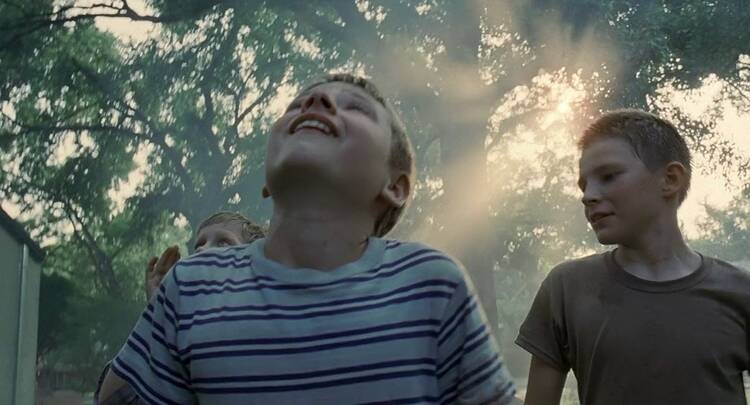It’s difficult to describe “The Tree of Life” (2011)—the Best Picture-nominated film written and directed by Terrence Malick—in a way that does it justice. The plot itself sounds fairly simple: On the anniversary of his brother’s early death, disaffected architect Jack (played by Sean Penn) reflects on his boyhood in suburban Texas in the 1950s (Hunter McCracken plays a young Jack) and his complicated relationship with his father (Brad Pitt). But the film uses this personal drama to reflect on bigger, existential themes. Spanning from the birth of the universe to the end of time, “The Tree of Life” ponders where God can be found in the midst of suffering.
Malick is a Christian director who often makes films with spiritual themes (most recently 2019’s “A Hidden Life,” about Blessed Franz Jägerstätter). “The Tree of Life” plays out like a long prayer, with Jack and his mother (Jessica Chastain) whispering their entreaties directly to God in voiceover. As much as the movie is about a family, it’s just as much about Jack’s relationship with God, and how it changes as he grows.
Jack’s image of God is shaped, consciously and unconsciously, by his relationship with his parents. In his gentle, graceful mother (Jessica Chastain), Jack sees a model of God’s unconditional love. She teaches him wonder and kindness and comforts him when he’s hurt or unsure. Malick and cinematographer Emmanuel Lubezki often depict her surrounded by an aura of gauzy sunlight, fragile and ethereal the way she must be in Jack’s memory: all that is good and pure in humanity.
But his father embodies a God who must be feared and obeyed, giving and taking away with capriciousness. He’s a man with rigid expectations and a constant stream of pronouncements that his sons are meant to take as gospel. (“It takes fierce will to get ahead in this world,” he tells Jack. “If you’re good, people take advantage of you.”) But he’s a hypocrite, unable to master his impulses or achieve his lofty ambitions. Jack resents him, even as he desires his love and approval. “Why does he hurt us, our father?” Jack whispers in a voiceover. It’s a two-part question: Why is their father the way he is, and why does God allow it?
In Jack’s mind, his parents represent the opposing forces of grace and nature. His mother introduces this dichotomy, saying (perhaps inspired by Malick’s own Irish Catholic mother) that she learned it from nuns growing up: “You have to choose which one you’ll follow.” The film offers a more complicated view, during a sweeping sequence that zooms out from the main story and takes us back to the Big Bang. We watch the stars form, see the fiery surface of the earth cool, bear witness as cells divide and life blooms beneath the oceans and on land. We linger in prehistory and see a dinosaur—supposedly the epitome of kill-or-be-killed natural instincts—spare another’s life: the birth of mercy.
This sequence suggests that grace and nature aren’t separate, but intertwined: nature springs from and is suffused by grace. Growing up, Jack glimpses the sacred in trees and rocky creeks, soft mattresses of grass and fistfuls of dirt: a world “charged with the grandeur of God,” in the words of Gerard Manley Hopkins, S.J.
Then how to explain suffering? The film opens with a line from the Book of Job: “Where were you when I laid the foundations of the Earth, when the morning stars sang together, and all the sons of God shouted for joy?” (Jb 38:4,7). In context, this is part of God’s response to Job’s questions about why the righteous suffer. More cynical commentators interpret it as a statement of authority, like something Jack’s father would say: Who are you to question me? But in “The Tree of Life,” it’s a statement of perspective. Our perspectives are limited by physical reality and linear time; we struggle to reconcile the beauty and pain of living, the consolation of love with the agony of loss. But if we could see through the eyes of God, perhaps we would see how all of life—even the darkest moments—are kissed by grace.
The end of the film takes us to the very end of time and a breathtaking vision of all things, and all people, being reconciled. That’s the scandal, mystery and beauty of faith: suffering and love, death and resurrection, exist side-by-side. Acknowledging this paradox doesn’t remove the sting of suffering or diminish God’s goodness. We find peace, as the film offers, by surrendering to the mystery with humility and grace.
“The Tree of Life” is streaming on Hulu.








